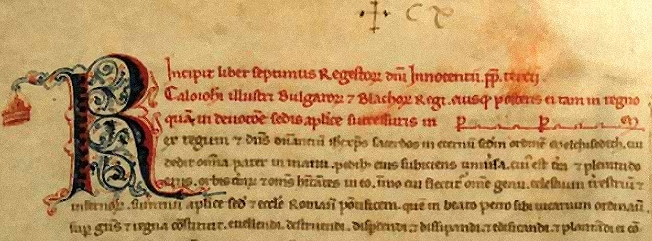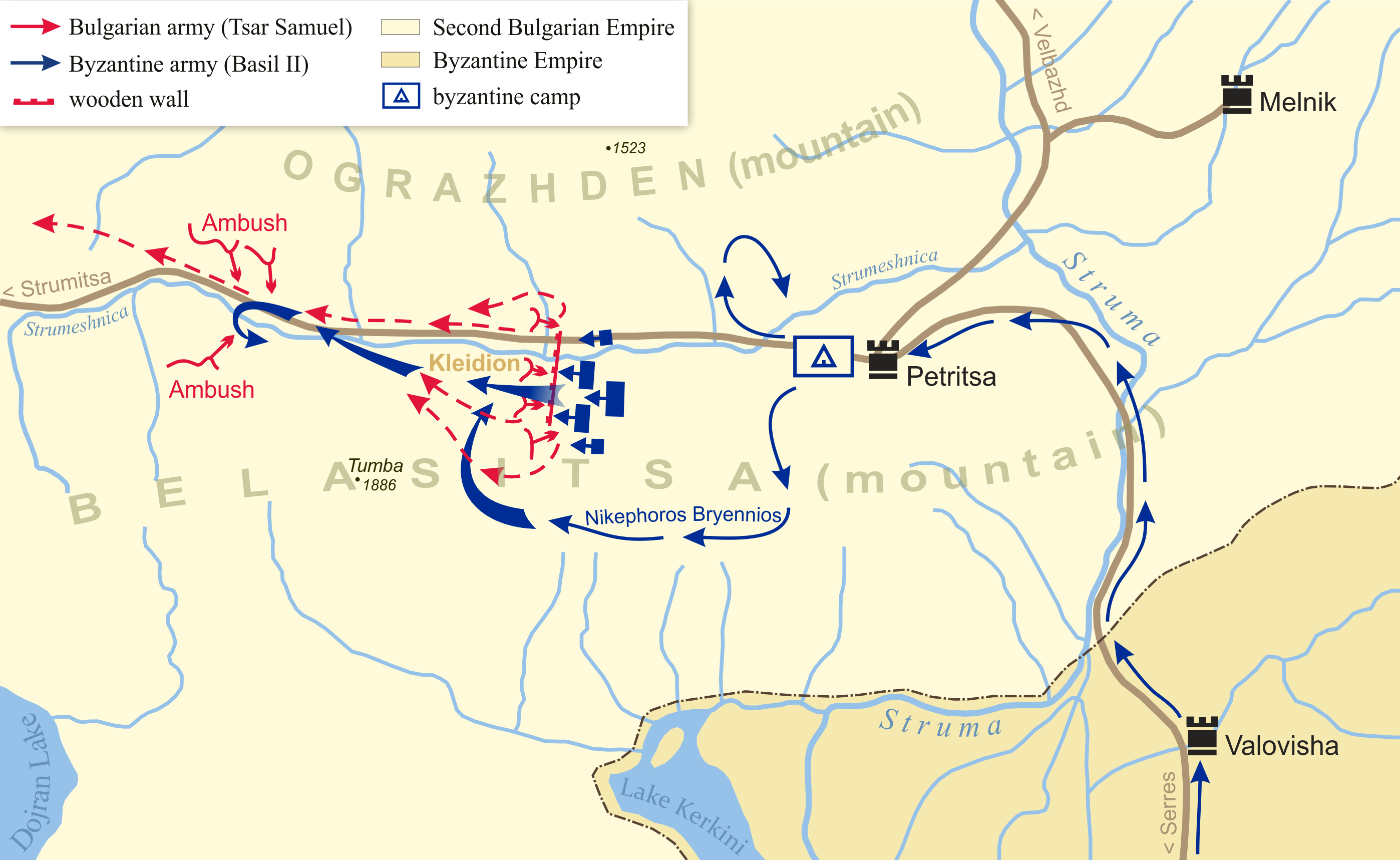|
Basil II
Basil II Porphyrogenitus (; 958 – 15 December 1025), nicknamed the Bulgar Slayer (, ), was the senior Byzantine emperor from 976 to 1025. He and his brother Constantine VIII were crowned before their father Romanos II died in 963, but they were too young to rule. The throne thus went to two generals, Nikephoros Phokas (963–969) and John Tzimiskes (r. 969–976) before Basil became senior emperor, though his influential great-uncle Basil Lekapenos remained as the '' de facto'' ruler until 985. His reign of 49 years and 11 months was the longest of any Roman emperor. The early years of Basil's reign were dominated by civil wars against two powerful generals from the Byzantine Anatolian aristocracy: first Bardas Skleros and later Bardas Phokas, which ended shortly after Phokas' death and Skleros' submission in 989. Basil then oversaw the stabilization and expansion of the eastern frontier of the Byzantine Empire and the complete subjugation of the First Bulgarian ... [...More Info...] [...Related Items...] OR: [Wikipedia] [Google] [Baidu] |
List Of Byzantine Emperors
The foundation of Constantinople in 330 AD marks the conventional start of the Eastern Roman Empire, which Fall of Constantinople, fell to the Ottoman Empire in 1453 AD. Only the emperors who were recognized as legitimate rulers and exercised sovereign authority are included, to the exclusion of junior co-emperors who never attained the status of sole or senior ruler, as well as of the List of Byzantine usurpers, various usurpers or rebels who claimed the imperial title. The following list starts with Constantine the Great, the first Christian emperor, who rebuilt the city of Byzantium as an imperial capital, Constantinople, and who was regarded by the later emperors as the model ruler. Modern historians distinguish this later phase of the Roman Empire as Byzantine due to the imperial seat moving from Rome to Byzantium, the Empire's integration of Christianity, and the predominance of Greek instead of Latin. The Byzantine Empire was the direct legal continuation of the eastern ... [...More Info...] [...Related Items...] OR: [Wikipedia] [Google] [Baidu] |
East-West Schism
East West (or East and West) may refer to: *East–West dichotomy, the contrast between Eastern and Western society or culture Arts and entertainment Books, journals and magazines *'' East, West'', an anthology of short stories written by Salman Rushdie * ''East and West'' (book), a 1998 book by Christopher Patten, the last British governor of Hong Kong *'' Philosophy East and West'', an international, interdisciplinary academic journal *''East and West'', a quarterly English-language journal published 1950 to 2009 by the Istituto Italiano per l'Africa e l'Oriente * '' Ost und West'', a German magazine Film, TV and theatre * '' East and West (film)'', a 1923 Austrian silent film *'' East/West'' (also known as ''Est-Ouest''), a 1999 film by Régis Wargnier * East West Players, an Asian American theatre organization *'' East West 101'', an Australian television drama series *'' Purab Aur Paschim'' (East and West), a 1970 Bollywood movie Music * ''East-West'' (The Butterfield Bl ... [...More Info...] [...Related Items...] OR: [Wikipedia] [Google] [Baidu] |
Kaloyan
Kaloyan or Kalojan, also known as Ivan I, Ioannitsa or Johannitsa (; 1170 – October 1207), the Roman Slayer, was emperor or tsar of Bulgaria from 1196 to 1207. He was the younger brother of Theodor and Asen, who led the anti-Byzantine uprising of the Bulgarians and Vlachs in 1185. The uprising ended with the restoration of Bulgaria as an independent state. He spent a few years as a hostage in Constantinople in the late 1180s. Theodor, crowned Emperor Peter II, made him his co-ruler after Asen was murdered in 1196. A year later, Peter was also murdered, and Kaloyan became the sole ruler of Bulgaria. After the successful siege of Varna in 1201 against the Byzantine Empire, the defenders and governors of the city were tied and thrown into the moat of the fortress walls and covered with dirt by the Bulgarians. After they were buried alive in this way, Kaloyan declared himself a Bulgarian avenger, adopting the moniker "the Romanslayer" by analogy with the emperor Basil II the ... [...More Info...] [...Related Items...] OR: [Wikipedia] [Google] [Baidu] |
Nicholas Mesarites
Nicholas Mesarites (; ca. 1163/4 – after 1216) was a Byzantine Greek churchman and writer, who eventually rose to the office of Metropolitan of Ephesus in the Empire of Nicaea. Life Born ca. 1163/4, Mesarites is first recorded in 1200, during the attempted coup of John Komnenos the Fat. At the time, Mesarites was '' skeuophylax'' of the Church of the Pharos in the Great Palace of Constantinople, and wrote an eyewitness account of the events. After the capture of Constantinople by the Fourth Crusade in 1204, he initially remained in the city. In late 1206, along with his brother John he participated in discussions between the Greek Orthodox clergy and the new Latin authorities, represented by the Latin Patriarch of Constantinople Thomas Morosini and the papal legate, Cardinal Benedict of Santa Susanna. The discussion failed to breach the rift between the two parties, as the Greeks refused to subordinate themselves to the Latin clergy. Following the death of his brother in ... [...More Info...] [...Related Items...] OR: [Wikipedia] [Google] [Baidu] |
Niketas Choniates
Niketas or Nicetas Choniates (; – 1217), whose actual surname was Akominatos (), was a Byzantine Greek historian and politician. He accompanied his brother Michael Akominatos to Constantinople from their birthplace Chonae (from which came his nickname, "Choniates" meaning "person from Chonae"). Nicetas wrote a history of the Eastern Roman Empire from 1118 to 1207. Life Nicetas Akominatos was born to wealthy parents around 1150 in Phrygia in the city of Chonae (near the modern Honaz in Turkey). Bishop Nicetas of Chonae baptized and named the infant; later he was called "Choniates" after his birthplace. When he was nine, his father dispatched him with his brother Michael to Constantinople to receive an education. Niketas' older brother greatly influenced him during the early stages of his life. He initially secured a post in the civil service, and held important appointments under the Angelos emperors (among them that of Grand Logothete or Chancellor) and was governor of ... [...More Info...] [...Related Items...] OR: [Wikipedia] [Google] [Baidu] |
Second Bulgarian Empire
The Second Bulgarian Empire (; ) was a medieval Bulgarians, Bulgarian state that existed between 1185 and 1422. A successor to the First Bulgarian Empire, it reached the peak of its power under Tsars Kaloyan of Bulgaria, Kaloyan and Ivan Asen II before gradually being conquered by the Ottoman Empire, Ottomans in the late 14th century. Until 1256, the Second Bulgarian Empire was the dominant power in the Balkans, defeating the Byzantine Empire in several major battles. In 1205, Emperor Kaloyan of Bulgaria, Kaloyan defeated the newly established Latin Empire in the battle of Adrianople (1205), Battle of Adrianople. His nephew Ivan Asen II defeated the Despotate of Epiros and made Bulgaria a regional power again. During his reign, Bulgaria spread from the Adriatic Sea, Adriatic to the Black Sea and the economy flourished. In the late 13th century, however, the Empire declined under constant invasions by Mongols, Byzantine Empire, Byzantines, Hungarians, and Serbia in the Middle Ages ... [...More Info...] [...Related Items...] OR: [Wikipedia] [Google] [Baidu] |
Battle Of Kleidion
The Battle of Kleidion (; or Clidium, after the medieval name of the village of Klyuch, ; also known as the Battle of Belasitsa) took place on 29 July 1014, between the Byzantine Empire and the Bulgarian Empire. It was the culmination of the nearly half-century struggle between the Byzantine Emperor Basil II and the Bulgarian emperor Samuel in the late 10th and early 11th centuries. The result was a decisive Byzantine victory. The battle took place in the valley between the mountains of Belasitsa and Ograzhden, near the modern Bulgarian village of Klyuch. The decisive encounter occurred on 29 July with an attack in the rear by a force under the Byzantine general Nikephoros Xiphias, who had infiltrated the Bulgarian positions. The ensuing battle was a major defeat for the Bulgarians. Thousands of Bulgarian soldiers were captured and blinded by order of Basil II, who would subsequently be known as the "Bulgar-Slayer". Samuel survived the battle, but died two months later fro ... [...More Info...] [...Related Items...] OR: [Wikipedia] [Google] [Baidu] |
Political Mutilation In Byzantine Culture
Mutilation was a common method of punishment for criminals in the Byzantine Empire, but it also had a role in the empire's political life. By blinding a rival, one would not only restrict his mobility but also make it almost impossible for him to lead an army into battle, then an important part of taking control of the empire. Castration was also used to eliminate potential opponents. In the Byzantine Empire, for a man to be castrated meant that he was no longer a man—half-dead, "life that was half death". Castration also eliminated any chance of heirs being born to threaten either the emperor's or the emperor's children's place at the throne. Other mutilations were the severing of the nose ( rhinotomy), or the amputating of limbs. Rationale The mutilation of political rivals by the emperor was deemed an effective way of side-lining from the line of succession a person who was seen as a threat. Castrated men were not seen as a threat, as no matter how much power they gained t ... [...More Info...] [...Related Items...] OR: [Wikipedia] [Google] [Baidu] |
Purple-born
Traditionally, born in the purple (sometimes "born to the purple") was a category of members of royal families born during the reign of their parent. This notion was later loosely expanded to include all children born of prominent or high-ranking parents. The parents must be prominent at the time of the child's birth so that the child is always in the spotlight and destined for a prominent role in life. A child born before their parents became prominent would not be "born in the purple". This color purple came to refer to Tyrian purple, restricted by law, custom, and the expense of creating it to royalty. ''Porphyrogénnētos'' (), Latinized as ''Porphyrogenitus'', was an honorific title in the Byzantine Empire given to a son, or daughter (, , Latinized ''Porphyrogenita''), born ''after'' the father had become emperor. Both imperial or Tyrian purple, a dye for cloth, and the purple stone porphyry were rare and expensive, and at times reserved for imperial use only. In particula ... [...More Info...] [...Related Items...] OR: [Wikipedia] [Google] [Baidu] |
Basil I
Basil I, nicknamed "the Macedonian" (; 811 – 29 August 886), was List of Byzantine emperors, Byzantine emperor from 867 to 886. Born to a peasant family in Macedonia (theme), Macedonia, he rose to prominence in the imperial court after gaining the favour of Emperor Michael III, whose Eudokia Ingerina, mistress he married on his emperor's orders. In 866, Michael proclaimed him co-emperor. Fearing a loss of influence, Basil orchestrated Michael's assassination the next year and installed himself as sole ruler of the empire. He was the first ruler of the Macedonian dynasty. Despite his humble origins, Basil was an effective and respected monarch. He initiated a complete overhaul of Byzantine law, an effort continued by his successor that ultimately became the ''Basilika''. On the foreign front, he achieved military success against the heretical Paulicianism, Paulicians, whom he subjugated in 872. He also pursued an active policy in the west, allying with Carolingian emperor Louis ... [...More Info...] [...Related Items...] OR: [Wikipedia] [Google] [Baidu] |
History Of The Decline And Fall Of The Roman Empire
''The History of the Decline and Fall of the Roman Empire'', sometimes shortened to ''Decline and Fall of the Roman Empire'', is a six-volume work by the English historian Edward Gibbon. The six volumes cover, from 98 to 1590, the peak of the Roman Empire, the history of early Christianity and its emergence as the Roman state religion, the Fall of the Western Roman Empire, the rise of Genghis Khan and Tamerlane and the fall of Byzantium, as well as discussions on the ruins of Ancient Rome. Volume I was published in 1776 and went through six printings. Volumes II and III were published in 1781; volumes IV, V, and VI in 1788–1789. The original volumes were published in quarto sections, a common publishing practice of the time. Conception and writing Gibbon's initial plan was to write a history "''of the decline and fall of the ''city'' of Rome''", and only later expanded his scope to the whole Roman Empire. Although he published other books, Gibbon devoted mu ... [...More Info...] [...Related Items...] OR: [Wikipedia] [Google] [Baidu] |
Edward Gibbon
Edward Gibbon (; 8 May 173716 January 1794) was an English essayist, historian, and politician. His most important work, ''The History of the Decline and Fall of the Roman Empire'', published in six volumes between 1776 and 1789, is known for the quality and irony of its prose, its use of primary sources, and its polemical Criticism of religion, criticism of organized religion. Early life: 1737–1752 Edward Gibbon was born in 1737, the son of Edward Gibbon (died 1770), Edward and Judith Gibbon, at Lime Grove in the town of Putney, Surrey. He had five brothers and one sister, all of whom died in infancy. His grandfather, also named Edward, had lost his assets as a result of the South Sea Company, South Sea bubble stock-market collapse in 1720 but eventually regained much of his wealth. Gibbon's father thus inherited a substantial estate. His paternal grandmother, Catherine Acton, was granddaughter of Sir Walter Acton, 2nd Baronet. Gibbon described himself as "a puny child, neg ... [...More Info...] [...Related Items...] OR: [Wikipedia] [Google] [Baidu] |









